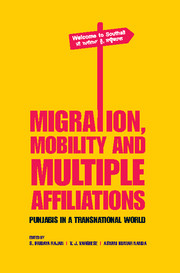Book contents
- Frontmatter
- Contents
- List of Tables and Figures
- Preface
- Acknowledgements
- Transnational World and Indian Punjab: Contemporary Issues
- Part I A Historical Survey
- 1 Punjabis in America
- 2 Punjabi–Sikh Migration: Latin America – A Geographic Profile
- 3 Punjabis/Sikhs in Canada
- 4 Punjabi Migration, Settlement and Experience in the UK
- Part II Shifting Contours of Migration
- Part III Social Structures and Organizational Links
- Part IV Education and Migration
- Part V Family Networks
- Contributors
- Index
3 - Punjabis/Sikhs in Canada
from Part I - A Historical Survey
Published online by Cambridge University Press: 05 March 2016
- Frontmatter
- Contents
- List of Tables and Figures
- Preface
- Acknowledgements
- Transnational World and Indian Punjab: Contemporary Issues
- Part I A Historical Survey
- 1 Punjabis in America
- 2 Punjabi–Sikh Migration: Latin America – A Geographic Profile
- 3 Punjabis/Sikhs in Canada
- 4 Punjabi Migration, Settlement and Experience in the UK
- Part II Shifting Contours of Migration
- Part III Social Structures and Organizational Links
- Part IV Education and Migration
- Part V Family Networks
- Contributors
- Index
Summary
Introduction
In May 2012 the oldest Sikh Temple in Victoria, British Columbia celebrated its hundredth year, a testimony to the history of Punjabi immigration to Canada. The Sikh community today is one of the largest and most deeply rooted ethnic communities in Canada. This chapter reviews the literature on the integration of the Punjabi/Sikh community in Canada. In the review of literature the authors have relied on academic books and book chapters, journal articles, newspaper reports and where possible official government data. In a few cases, data cames from findings of research undertaken by reputed and well-established community organizations.
Academic research and statistical data in Canada focused on ethnic groups collapse the Punjabi/Sikh community under the heading ‘South Asians’ that includes persons who can trace their origins to India, Pakistan, Bangladesh and Nepal. In doing so, much information about the unique features of the Punjabi/Sikh (and other communities) is lost. This chapter tries not to utilize such data as the category ‘South Asian’ is extremely diverse and could overwhelm the focus on Punjabis/Sikhs that this book strives to achieve. The discussion of the integration of the Punjabi/Sikh community in Canada works within the limitations of this lack of data.
This introduction to the chapter is followed by the following sections – an overview of the concept of immigrant integration and its dimensions; a look at Punjabi/Sikh immigration to Canada through the years and dimensions of economic, social, cultural and political integration for the Punjabi/Sikh community. The chapter concludes with a discussion of the findings.
Punjabi/Sikh immigration to Canada through the years
The early Punjabi migrants to Canada were largely Sikhs with little education from the Indian districts of Jalandhar, Ferozepur, Ludhiana, Amritsar and Gurdaspur (Verma, 2003). These early migrants came to Canada in the early 1900s with dreams of a more secure financial future for their families – primarily through remittances – than what they faced in Punjab (Manak, 1998; Singh, 1994). The caste groupings prevailed even in Canada in the early years and determined the immigrants’ cultural practices in their host country (Verma, 2003).
Sikhism continues to grow in Canada due to the continued immigration of Punjabis over the years. O'Connell (2000) divides the history of Sikhs in Canada into two broad periods – the early to mid-1900s and then the period from 1960 till current days.
- Type
- Chapter
- Information
- Migration, Mobility and Multiple AffiliationsPunjabis in a Transnational World, pp. 91 - 104Publisher: Cambridge University PressPrint publication year: 2015
- 3
- Cited by



